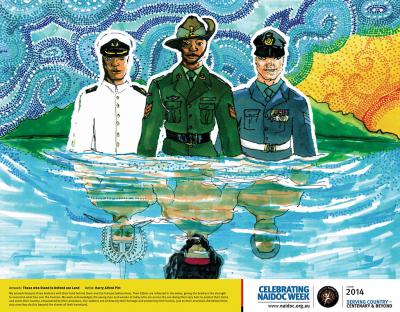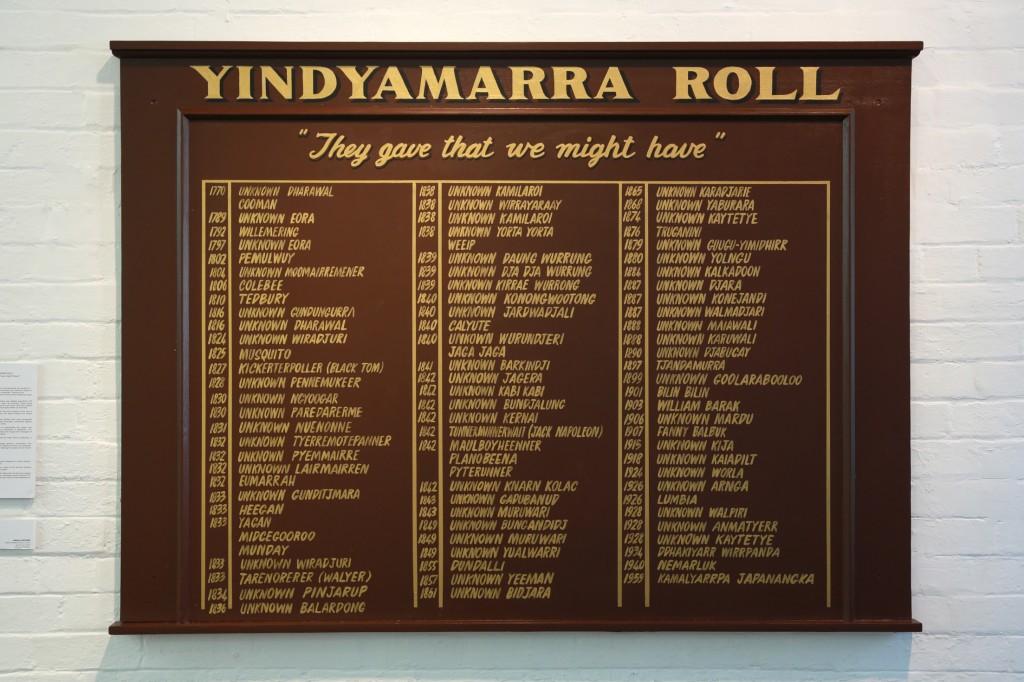There’s a repost below of something that first appeared on the Honest History site more than nine years ago (Updates July-November 2014) during NAIDOC Week 2014. It shows Honest History’s early engagement with the need to properly remember the Australian Frontier Wars.
Now, with others, we have formed an association, Defending Country Memorial Project Inc.*, to push for that depiction and commemoration to happen – soon, and particularly at the Australian War Memorial. This is necessary truth-telling.
More of our case can be found on the Honest History home page and there is more to come. The item below was part of a series ‘First Peoples’ which we ran as a ‘special subject’ from 2014 to 2017. The original post included many links to related material.
1 October 2023
* Defending Country Memorial Project Inc., has been formed to encourage the Australian War Memorial to properly recognise and commemorate the Frontier Wars. Its members are Noel Turnbull (Secretary), Professor Peter Stanley, Dr David Stephens, Dr Carolyn Holbrook and Pamela Burton.
***
NAIDOC Week is 6-13 July. The theme for this year is ‘Serving Country – Centenary & Beyond’. The centenary referred to is the Anzac centenary. The word ‘Beyond’ is intended to take us back – back to when Indigenous Australians served their country without wearing the Queen’s uniform, indeed, when they fought against those who wore that uniform – and forward to the future.
The NAIDOC website says this about the theme.
This year’s NAIDOC theme honours all Aboriginal and Torres Strait Islander men and women who have fought in defence of country. From our warriors in the Frontier Wars to our warriors who have served with honour and pride in Australia’s military conflicts and engagements across the globe. We proudly highlight and recognise the role they have played in shaping our identity and pause to reflect on their sacrifice. We celebrate and honour their priceless contribution to our nation.
The words are notable for recognising both uniformed service, by approximately 4000 Indigenous Australians, and the Frontier Wars, where perhaps 30 000 Indigenous warriors, women and children were killed, the most recent in the 1930s.
NAIDOC Week 2014, official poster, Harry Alfred Pitt (source: NAIDOC website)
The official poster (by Harry Alfred Pitt, from the Torres Strait) has Indigenous Australian warriors reflected in the water. Still, the most obvious feature of the artwork is the uniforms. The Frontier Wars are further referenced on the lower left of the poster: ’empowered by their ancestors. Our soldiers are embracing their heritage and protecting their homes, just as their ancestors did before them … ‘.
On the other hand, there is the work of Amala Groom, a Wiradjuri woman and Sydney-based artist.
Yindyamarra Roll, Amala Groom (source: artist; photo: Liz Warning)
Amala has provided a statement about the work ARTIST STATEMENT Amala Groom. It includes this claim.
To maintain the fiction that Australia was settled “peacefully” the wars fought on the frontier will never be honored. These brave warriors who fought for kin and country will never hold their rightful place in the narrative of the colonial project known as Australia. Their loss of life will never be given the same respect as the loss of the life of the ANZACs, the diggers, the great Aussies who fought under the Australian flag. The thousands of men, women and children who were devastated from the countless massacres and atrocities committed against them will never be dignified by the state.
Amala goes on to talk about her work.
The use of Western symbology to memorialise the known and unknown heroes of the resistance movement is deliberate. The Yindyamarra Roll is a tribute to those who fought the onslaught of the colonial invasion of their tribal lands. These warriors gave their lives that we might have a language, a lore, a clan, a nation, and a family.
Comment by David Stephens
The dual references in the NAIDOC Week theme are welcome although one wonders whether the message will be blunted by its subtlety. Amala Groom’s work has a more direct thrust. The different emphases reflect different attitudes among Indigenous Australians.
We understand that NAIDOC Week celebrations will commemorate both the dead of the Frontier Wars and those who died wearing Australian uniforms. Meanwhile, however, what non-Indigenous Australians see from official sources is dominated by one side of the story, the recognition of Indigenous service in uniform.
This service is being promoted by the Defence Department, the Army, the Australian War Memorial, the Department of Veterans’ Affairs, the Serving Our Country research project and others. Typical of this material is the Army’s section on Indigenous soldiers, which says that ‘Indigenous service men and women have served our nation since the Boer War’ (emphasis added).
It is not for whitefellas and other non-Indigenous Australians to lead a campaign to have Australia adequately recognise the dead of the Frontier Wars, though there are plenty of whitefellas who would support such a campaign led by blackfellas, should blackfellas wish to lead one. Nor is it for non-Indigenous Australians to suggest tactics to Indigenous Australians.
Anything that gives long overdue recognition to Indigenous service is welcome. It needs to be asked, however, whether these efforts are intended, by some of those doing the promoting, to divert attention from awkward truths about conflicts where Indigenous warriors did not wear the Queen’s uniform.
The stories of the Frontier Wars have been part of the heritage of Indigenous Australians, particularly where family members suffered in incidents or heard the stories directly from those who did. Indigenous Australians also rightly honour the more recent service of their family members in uniform. Both forms of service will be remembered during NAIDOC Week but the fact remains that, for non-Indigenous Australians looking on, Indigenous uniformed service is gaining a higher profile than the Frontier Wars. We are being told – and being told increasingly well – less than half the story …
NAIDOC stands for National Aborigines and Islanders Day Observance Committee. The NAIDOC Secretariat is in the Strategic Communications area of the Department of the Prime Minister and Cabinet. The co-chairs of NAIDOC are Anne Martin and Benjamin Mitchell.




Leave a Reply
You must be logged in to post a comment.